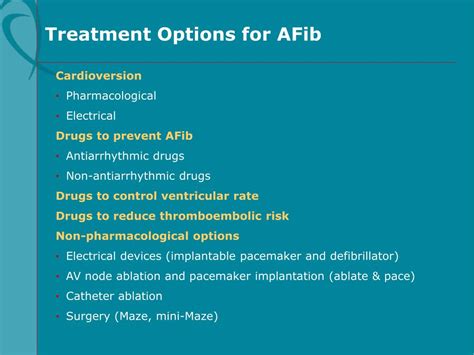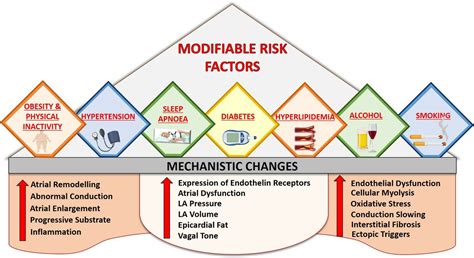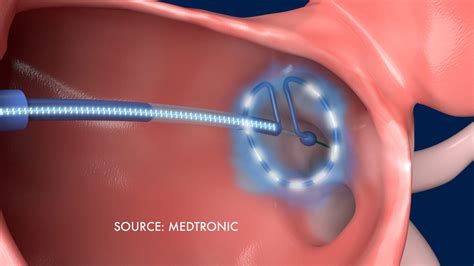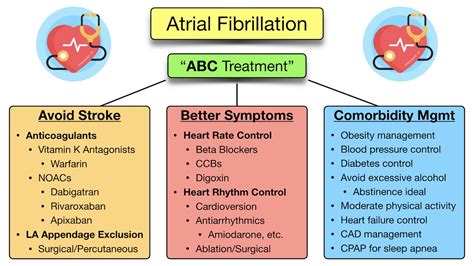Intro
Discover 5 effective ways to treat Afib, including medication, cardioversion, and lifestyle changes, to manage atrial fibrillation symptoms, prevent stroke, and improve heart health with natural remedies and surgical options.
Atrial fibrillation, commonly referred to as Afib, is a type of irregular heartbeat that can increase the risk of stroke, heart failure, and other heart-related complications. It is estimated that over 2.7 million Americans are living with Afib, and the condition is more prevalent among older adults. Treating Afib is crucial to prevent these complications and improve the quality of life for individuals affected by the condition. In this article, we will explore the various treatment options available for Afib, including medications, lifestyle changes, and surgical procedures.
The importance of treating Afib cannot be overstated. If left untreated, Afib can lead to serious health consequences, including stroke, heart failure, and even death. Furthermore, Afib can significantly impact an individual's quality of life, causing symptoms such as palpitations, shortness of breath, and fatigue. Fortunately, there are several effective treatment options available for Afib, and with the right treatment, individuals can manage their symptoms and reduce their risk of complications.
Treating Afib requires a comprehensive approach that takes into account the individual's overall health, medical history, and lifestyle. While there is no cure for Afib, various treatment options can help manage the condition and prevent complications. In the following sections, we will delve into the different treatment options available for Afib, including medications, lifestyle changes, and surgical procedures. We will also discuss the benefits and risks associated with each treatment option, as well as the importance of working with a healthcare provider to develop a personalized treatment plan.
Treatment Options for Afib

There are several treatment options available for Afib, including medications, lifestyle changes, and surgical procedures. The goal of treatment is to restore a normal heart rhythm, prevent stroke, and improve symptoms. Medications are often the first line of treatment for Afib, and they can help control heart rate and rhythm. Lifestyle changes, such as maintaining a healthy weight, exercising regularly, and managing stress, can also help manage Afib symptoms. In some cases, surgical procedures, such as cardioversion or ablation, may be necessary to restore a normal heart rhythm.
Medications for Afib
Medications are often used to treat Afib, and they can help control heart rate and rhythm. There are several types of medications available, including beta blockers, calcium channel blockers, and antiarrhythmic medications. Beta blockers, such as metoprolol and atenolol, can help slow the heart rate and reduce symptoms. Calcium channel blockers, such as verapamil and diltiazem, can help control heart rate and rhythm. Antiarrhythmic medications, such as amiodarone and sotalol, can help restore a normal heart rhythm.Lifestyle Changes for Afib

Lifestyle changes can play an important role in managing Afib symptoms. Maintaining a healthy weight, exercising regularly, and managing stress can help reduce symptoms and improve overall health. A healthy diet that is low in salt, sugar, and unhealthy fats can also help manage Afib symptoms. Additionally, avoiding triggers such as caffeine, alcohol, and tobacco can help reduce symptoms.
Exercise and Afib
Exercise is an important part of managing Afib symptoms. Regular physical activity can help improve heart health, reduce symptoms, and improve overall quality of life. However, it is essential to talk to a healthcare provider before starting an exercise program, especially if you have any underlying health conditions. Aerobic exercises, such as walking, jogging, and cycling, can help improve heart health and reduce symptoms. Strength training exercises, such as weightlifting and resistance band exercises, can also help improve overall health and reduce symptoms.Surgical Procedures for Afib

In some cases, surgical procedures may be necessary to restore a normal heart rhythm. Cardioversion is a procedure that uses electrical shocks to restore a normal heart rhythm. Ablation is a procedure that uses heat or cold to destroy the abnormal electrical pathways in the heart that are causing the arrhythmia. Surgical maze procedures involve creating a pattern of scar tissue in the heart to block the abnormal electrical pathways and restore a normal heart rhythm.
Cardioversion for Afib
Cardioversion is a procedure that uses electrical shocks to restore a normal heart rhythm. The procedure is typically performed in a hospital setting, and it can be done under local anesthesia or sedation. During the procedure, a healthcare provider will use a defibrillator to deliver an electrical shock to the heart. The shock can help restore a normal heart rhythm, and it can also help improve symptoms.Benefits and Risks of Afib Treatment

While treatment can help manage Afib symptoms and reduce the risk of complications, there are also benefits and risks associated with each treatment option. Medications can have side effects, such as dizziness, fatigue, and nausea. Lifestyle changes can be challenging to implement, especially for individuals who are used to a sedentary lifestyle. Surgical procedures can have risks, such as bleeding, infection, and scarring.
Risks of Afib Treatment
The risks of Afib treatment vary depending on the treatment option. Medications can have side effects, and they can also interact with other medications. Lifestyle changes can be challenging to implement, and they may not be effective for everyone. Surgical procedures can have risks, such as bleeding, infection, and scarring. It is essential to talk to a healthcare provider about the benefits and risks associated with each treatment option to determine the best course of treatment.Working with a Healthcare Provider

Working with a healthcare provider is essential to develop a personalized treatment plan for Afib. A healthcare provider can help determine the best course of treatment based on an individual's overall health, medical history, and lifestyle. They can also provide guidance on lifestyle changes, such as diet and exercise, and they can help monitor the effectiveness of treatment.
Monitoring Afib Treatment
Monitoring Afib treatment is crucial to ensure that the treatment is effective and to make any necessary adjustments. A healthcare provider can use various tests, such as electrocardiograms (ECGs) and Holter monitors, to monitor the heart rhythm and determine the effectiveness of treatment. They can also use blood tests to monitor for any potential side effects of medications.What are the symptoms of Afib?
+The symptoms of Afib can include palpitations, shortness of breath, fatigue, and dizziness. However, some individuals may not experience any symptoms at all.
How is Afib diagnosed?
+Afib is typically diagnosed using an electrocardiogram (ECG), which is a test that measures the heart's electrical activity. A healthcare provider may also use other tests, such as a Holter monitor or an event monitor, to diagnose Afib.
What are the risks of untreated Afib?
+Untreated Afib can increase the risk of stroke, heart failure, and other heart-related complications. It can also significantly impact an individual's quality of life, causing symptoms such as palpitations, shortness of breath, and fatigue.
In conclusion, treating Afib is crucial to prevent complications and improve the quality of life for individuals affected by the condition. With the right treatment, individuals can manage their symptoms and reduce their risk of complications. We invite you to share your thoughts and experiences with Afib treatment in the comments below. If you found this article helpful, please share it with others who may be affected by Afib. By working together, we can raise awareness about Afib and promote effective treatment options.
